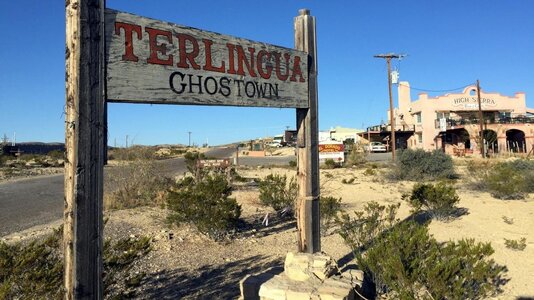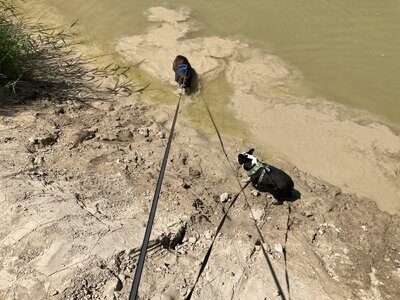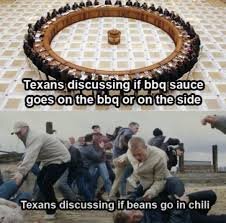- Joined
- Apr 15, 2023
- Messages
- 2,555
- Reaction score
- 16,987
First, a history lesson:
Translated, chili con carne is chilis with meat. This is the basic fundamental so if you shorten the name to simply chili and add something xtra then it becomes chili with beans, chili with pasta (Yeah fuck that "Cincinnati Chili". It's chili with pasta) chili with whatever your evil mother in law drops in there, etc. You get the idea.
Yet this excludes garnishment so it's not chili with crackers, chili with cornbread, chili with cheese and so on. Garnishments are added on after the cook so that's why they're excluded.
My chili recipe was born in West Texas.
Terlingua Ghost Town to be exact.
A place isolated and stuck in time. Where there's more rattlesnakes in the roads than cars, the people wear .50 cal hand cannons on the hip, and ride horses to the local saloon.
Tall tales are spun on "The Porch" to captivate tourists and when night falls, the show begins with one of the best stargazing night skies the planet has to offer



When I serve somebody a bowl of chili, I'm looking to change their life. I want to give you something so delicious and and warm it touches your soul.
Chili is much more than food to me you could say. And it's certainly not a "side dish".
A good pot of Texas Red is ez to make but it's not fast.
I use things like fire and smoke fueled by woods like post oak, hickory, and my favorite, mesquite.
I prefer cast iron and Dutch ovens over electric slow cookers but have come around to induction cooktops when I'm not up to managing a smoker or camp fire for 8-10 hours.
I prefer fresh and raw ingredients over anything processed and canned with the exception of tomatoes, chipotles, and broth. And of course, beer
The fundamentals of chili are fairly standard across many regions. It's the extras and special ingredients which elevate the dish to new levels.
Time is another special ingredient. While yes chili is technically done when it's at 165*F or roughly around 3 hours at a low simmer, my chili stays on the heat for 8-10 hours. If I'm smoking it, 4 hours in smoke, 4 hours with the lid on the pot. I want those flavors to melt into one. That collagen in the meat to break down into liquid form and this takes time.
I don't measure much. Measuring is for nerds so I cook to taste and yes my chili is 2 alarm fire hot.

So, I've got my list ready and now it's time to go grocery shopping
![IMG_8243[1].jpeg IMG_8243[1].jpeg](https://budbuilders.org/data/attachments/52/52957-a5fe048563b5c57c5aeb9fa9475a890d.jpg)
Feel free to post your own thoughts, recipes, throw shade, and talk shit now.
Like I said, this is gonna be a slow burn and I'm thinking ready sometime around Friday.
TBC......
As with any popular food, there are many legends surrounding the origins of chili con carne. Some sources describe a very similar dish dating back to the Aztec world in the 1500s. One legend involves a divine figure called 'the Lady in Blue' who spoke of a spicy, red-hot stew that sounds much like chili con carne.
Most sources agree that the dish was widely consumed by the 1800s and the Civil War period in the United States, especially in the southwest. The earliest description of chili comes from an 1828 journal…Recounting a visit to San Antonio, J. C. Clopper writes about it as a kind of hash with nearly as many peppers as there are pieces of meat this is all stewed together.
Historians often cite Texas as the birthplace of chili con carne. In 1850 - Records were found by Everrette DeGolyer (1886-1956), a Dallas millionaire and a lover of chili, indicating that the first chili mix was concocted around 1850 by Texan adventurers and cowboys as a staple for hard times when traveling to and in the California gold fields and around Texas. Needing hot grub, the trail cooks came up with a sort of stew. They pounded dried beef, fat, pepper, salt, and the chili peppers together. This amounted to "brick chili" or "chili bricks" that could be boiled in pots along the trail. DeGolyer said that chili should be called "chili a la Americano" because the term chili is generic in Mexico and simply means a hot pepper. He believed that chili con carne began as the "pemmican of the Southwest."
The 1893 World's Fair in Chicago introduced the dish to many Americans that had never tried it before, leading to increased popularity. Ingredients and store-bought variations became widely available in grocery stores as the demand increased.
Many regions in the southwest became known for their chili parlors, which became even more prevalent following the rise in consumption of chili con carne. The version of chili con carne that appeared in the 1800s was particularly popular in Texas and the northern Mexico region. Each chili parlor claimed to have an original recipe or a secret ingredient, a trend that still exists today.
Translated, chili con carne is chilis with meat. This is the basic fundamental so if you shorten the name to simply chili and add something xtra then it becomes chili with beans, chili with pasta (Yeah fuck that "Cincinnati Chili". It's chili with pasta) chili with whatever your evil mother in law drops in there, etc. You get the idea.
Yet this excludes garnishment so it's not chili with crackers, chili with cornbread, chili with cheese and so on. Garnishments are added on after the cook so that's why they're excluded.
My chili recipe was born in West Texas.
Terlingua Ghost Town to be exact.
A place isolated and stuck in time. Where there's more rattlesnakes in the roads than cars, the people wear .50 cal hand cannons on the hip, and ride horses to the local saloon.
Tall tales are spun on "The Porch" to captivate tourists and when night falls, the show begins with one of the best stargazing night skies the planet has to offer



When I serve somebody a bowl of chili, I'm looking to change their life. I want to give you something so delicious and and warm it touches your soul.
Chili is much more than food to me you could say. And it's certainly not a "side dish".
A good pot of Texas Red is ez to make but it's not fast.
I use things like fire and smoke fueled by woods like post oak, hickory, and my favorite, mesquite.
I prefer cast iron and Dutch ovens over electric slow cookers but have come around to induction cooktops when I'm not up to managing a smoker or camp fire for 8-10 hours.
I prefer fresh and raw ingredients over anything processed and canned with the exception of tomatoes, chipotles, and broth. And of course, beer
The fundamentals of chili are fairly standard across many regions. It's the extras and special ingredients which elevate the dish to new levels.
Time is another special ingredient. While yes chili is technically done when it's at 165*F or roughly around 3 hours at a low simmer, my chili stays on the heat for 8-10 hours. If I'm smoking it, 4 hours in smoke, 4 hours with the lid on the pot. I want those flavors to melt into one. That collagen in the meat to break down into liquid form and this takes time.
I don't measure much. Measuring is for nerds so I cook to taste and yes my chili is 2 alarm fire hot.
So, I've got my list ready and now it's time to go grocery shopping
![IMG_8243[1].jpeg IMG_8243[1].jpeg](https://budbuilders.org/data/attachments/52/52957-a5fe048563b5c57c5aeb9fa9475a890d.jpg)
Feel free to post your own thoughts, recipes, throw shade, and talk shit now.
Like I said, this is gonna be a slow burn and I'm thinking ready sometime around Friday.
TBC......
Last edited:









![IMG_8247[1].jpeg IMG_8247[1].jpeg](https://budbuilders.org/data/attachments/52/52979-e73894d38225d09eb7197f86585b92ac.jpg)

![IMG_8247[1].jpeg IMG_8247[1].jpeg](https://budbuilders.org/data/attachments/52/52992-faa7e5746957ebc0f77a9269ac663b21.jpg)
![IMG_8257[1].jpeg IMG_8257[1].jpeg](https://budbuilders.org/data/attachments/53/53132-7e8faaddf4683aec2416bb822ac6443b.jpg)
![IMG_8259[1].jpeg IMG_8259[1].jpeg](https://budbuilders.org/data/attachments/53/53133-d66ffa5c4280261f0b7aedba52b4977d.jpg)
![IMG_8264[1].jpeg IMG_8264[1].jpeg](https://budbuilders.org/data/attachments/53/53134-c1597c76f65dcbebbcf0b5dfd3a967d6.jpg)
![IMG_8266[1].jpeg IMG_8266[1].jpeg](https://budbuilders.org/data/attachments/53/53383-5db45e129673f35847ea403875c2cc18.jpg)
![IMG_8267[1].jpeg IMG_8267[1].jpeg](https://budbuilders.org/data/attachments/53/53384-21665f7e1f06d8d5d85b083f1a3dbaa4.jpg)
![IMG_8269[1].jpeg IMG_8269[1].jpeg](https://budbuilders.org/data/attachments/53/53385-086527cfb4b062de820da0919d1fc804.jpg)
![IMG_8271[1].jpeg IMG_8271[1].jpeg](https://budbuilders.org/data/attachments/53/53386-c4ea78e5b637b5669bd42febc0b0f229.jpg)
![IMG_0744[1].jpeg IMG_0744[1].jpeg](https://budbuilders.org/data/attachments/53/53402-e2e6fa7385e83ebbfb01c4400267df37.jpg)

![IMG_8276[1].jpeg IMG_8276[1].jpeg](https://budbuilders.org/data/attachments/53/53401-bc7a76e44c3d749351d75dc6bae33d54.jpg)





